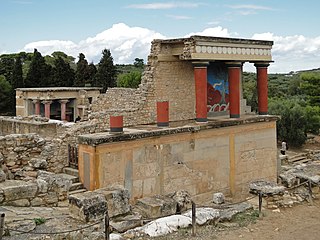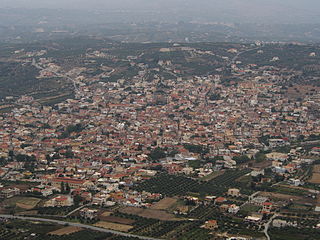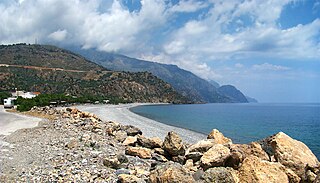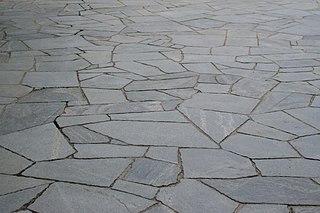Related Research Articles

Crete is the largest and most populous of the Greek islands, the 88th largest island in the world and the fifth largest island in the Mediterranean Sea, after Sicily, Sardinia, Cyprus, and Corsica. Crete rests about 160 km (99 mi) south of the Greek mainland, and about 100 km (62 mi) southwest of Anatolia. Crete has an area of 8,336 km2 (3,219 sq mi) and a coastline of 1,046 km (650 mi). It bounds the southern border of the Aegean Sea, with the Sea of Crete to the north and the Libyan Sea to the south.

In Greek mythology, the Labyrinth was an elaborate, confusing structure designed and built by the legendary artificer Daedalus for King Minos of Crete at Knossos. Its function was to hold the Minotaur, the monster eventually killed by the hero Theseus. Daedalus had so cunningly made the Labyrinth that he could barely escape it after he built it.

The Minoan civilization was a Bronze Age Aegean civilization on the island of Crete and other Aegean Islands, whose earliest beginnings were from c. 3500 BC, with the complex urban civilization beginning around 2000 BC, and then declining from c. 1450 BC until it ended around 1100 BC, during the early Greek Dark Ages. It represents the first advanced civilization in Europe, leaving behind a number of massive building complexes, sophisticated art, and writing systems. Its economy benefited from a network of trade around much of the Mediterranean.

Knossos is the largest Bronze Age archaeological site on Crete and has been called Europe's oldest city.

The history of Crete goes back to the 7th millennium BC, preceding the ancient Minoan civilization by more than four millennia. The palace-based Minoan civilization was the first civilization in Europe.

In American English, walkway is a composite or umbrella term for all engineered surfaces or structures which support the use of trails.

A portico is a porch leading to the entrance of a building, or extended as a colonnade, with a roof structure over a walkway, supported by columns or enclosed by walls. This idea was widely used in ancient Greece and has influenced many cultures, including most Western cultures.

The Ishtar Gate was the eighth gate to the inner city of Babylon. It was constructed circa 575 BCE by order of King Nebuchadnezzar II on the north side of the city. It was part of a grand walled processional way leading into the city. The walls were finished in glazed bricks mostly in blue, with animals and deities in low relief at intervals, these also made up of bricks that are molded and colored differently.

A larnax is a type of small closed coffin, box or "ash-chest" often used in the Minoan civilization and in Ancient Greece as a container for human remains—either a corpse or cremated ashes.

Sacred dance is the use of dance in religious ceremonies and rituals, present in most religions throughout history and prehistory. Its connection with the human body and fertility has caused it to be forbidden by some religions; for example, its acceptability in Christianity has varied widely. Dance has formed a major element of worship in Hindu temples, with strictly formalized styles such as Bharatanatyam, which require skilled dancers and temple musicians. In the 20th century, sacred dance has been revived by choreographers such as Bernhard Wosien as a means of developing community spirit.

A rosette is a round, stylized flower design.

Archanes is a former municipality in the Heraklion regional unit, Crete, Greece. Since the 2011 local government reform it is part of the municipality Archanes-Asterousia, of which it is a municipal unit. The municipal unit has an area of 31.516 km2 (12.168 sq mi). Population 5,042 (2011). It is also the archaeological site of an ancient Minoan settlement in central Crete. The discovery of ancient roads leading from Archanes to Juktas, Anemospilia, Xeri Kara and Vathypetro indicate that Archanes was an important hub in the region during Minoan times. Archaeological evidence indicates that ancient Archanes spread out over the same area as the modern town of Archanes.

In traditional Persian architecture, a kucheh or koocheh, is a narrow especially designed alley. Remnants of it are still seen in modern Iran and regional countries.

Souda Bay is a bay and natural harbour near the town of Souda on the northwest coast of the Greek island of Crete. The bay is about 15 km long and only two to four km wide, and a deep natural harbour. It is formed between the Akrotiri peninsula and Cape Drapano, and runs west to east. The bay is overlooked on both sides by hills, with a relatively low and narrow isthmus in the west near Chania.

Kissamos is a town and a municipality in the west of the island of Crete, Greece. It is part of the Chania regional unit and of the former Kissamos Province which covers the northwest corner of the island. The town of Kissamos is also known as Kastelli Kissamou and often known simply as Kastelli after the Venetian castle that was there. It is now a port and fishing harbour, with a regular ferry from the Peloponnese via Kythira. A town museum is located in the old Venetian governor's palace and there have been important archaeological finds in the town, including fine mosaics, dating from the Roman city of Kisamos. The head town of the municipality is Kastelli-Kissamos itself.

Sougia is a community and a small village in Chania regional unit on the island of Crete, Greece. It is part of the municipal unit of East Selino. It is located on the south coast of the island, 70 km south of Chania. The community consists of the following villages :

The Kanephoros was an honorific office given to unmarried young women in ancient Greece, which involved the privilege of leading the procession to sacrifice at festivals; the highest honour was to lead the pompe (πομπή) at the Panathenaic Festival. The role was given to a virgin selected from amongst the aristocratic or Eupatrid families of Athens whose purity and youth was thought essential to ensure a successful sacrifice. Her task was to carry a basket or kanoun (κανοῦν), which contained the offering of barley or first fruits, the sacrificial knife and fillets to decorate the bull, in procession through the city up to the altar on the acropolis.

Crazy paving is a means of hard-surfacing used outdoors, most frequently in gardens. Paving stones of irregular size and shape are laid in a haphazard manner sometimes with mortar filling the gaps between.
A Processional is anything of, and or pertaining to a procession.

Montisi is an Italian village in the municipality of Montalcino, Province of Siena, Tuscany. It sits on a hill on the boundary between the Val d'Orcia and the Crete Senesi.
References
- ↑ Barbara N. Porter, Images, Power, and Politics: Figurative Aspects of Esarhaddon's Babylonia, 1993, Diane Publishing ISBN 978-0-87169-208-5
- ↑ C.Michael Hogan, Knossos Fieldnotes, The Modern Antiquarian (2007)
- ↑ Steven L. Cantor, Contemporary Trends in Landscape Architecture, 1996, John Wiley and Sons, United States, 348 pages ISBN 0-471-28791-1